Papers by Annica Dahlström
Archives of Histology and Cytology, 1989
Human endocrine tumours were studied in in vitro systems (cell suspensions and tissue cultures) a... more Human endocrine tumours were studied in in vitro systems (cell suspensions and tissue cultures) and in in vivo systems (tumour transplants to the anterior eye-chamber of immunosuppressed rats). In the experimental systems the tumour cells were demonstrated to synthesize and secrete the same hormonal
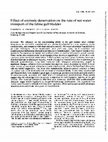
Gut, Jun 1, 1984
The influence on the concentrating ability of the gall bladder after extrinsic denervation was st... more The influence on the concentrating ability of the gall bladder after extrinsic denervation was studied in anaesthetised cats, previously subjected to truncal vagotomy and/or coeliacectomy, and compared with sham operated controls. Net water absorption was studied by perfusion techniques. Acute experiments were performed under basal conditions and ax-adrenoceptor stimulation (intra-arterial infusion of noradrenaline). Gall bladder biopsies were studied by fluorescence microscopy and cytofluorimetry to visualise and quantify catecholamines. Three weeks after coeliacectomy basal absorption had decreased significantly. In the short term vagotomy group no changes were shown. In the long term vagotomy group, however, there was a four-fold increase in absorptive capacity, which decreased to control levels after o-adrenoceptor blockade (phentolamine). Long term vagotomy with subsequent coeliacectomy caused no significant changes. Infusion of noradrenaline increased net water absorption by 60±11% in all experimental groups except in long term vagotomised animals, where the high basal absorption was not further augmented. One hour after noradrenaline infusion controls returned to basal absorption rate, while denervated cats remained at stimulated levels. In long term vagotomised gall bladders there were morphological signs of adrenergic proliferation (increased total number of nerve terminals, sprouting and raised levels of intraneuronal noradrenaline). These results suggest that the adrenergic nervous system is important for full absorptive capacity of the gall bladder. The increased absorption after long term vagotomy, abolished after ax-adrenoceptor blockade, might well be explained by the parallel adrenergic proliferation. This hypothesis was further corroborated in animals with long term vagotomy, where subsequent surgical adrenergic denervation restored basal absorption to control levels.
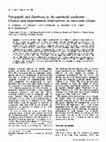
British Journal of Cancer, Aug 1, 1986
A patient with the midgut carcinoid syndrome with severe diarrhoea and proven hypersecretion of s... more A patient with the midgut carcinoid syndrome with severe diarrhoea and proven hypersecretion of serotonin (5-HT) was treated with low doses of verapamil perorally. During treatment the patient was completely relieved of diarrhoea but discrete facial flushing persisted during treatment. When treatment was cessated, diarrhoeas recurred. This patient underwent pentagastrin (PG) provocation repeatedly; during untreated conditions injection of PG released 5-HT, detectable in peripheral venous blood. Such release was abolished during verapamil treatment, but recurred after withdrawal of the drug. Surgical biopsies from this tumour were studied in two experimental models: cell suspensions and heterotransplants grown in the anterior eye-chamber of immunosuppressed rats. Release of 5-HT from the cell suspensions was elicited in a dosedependent manner after stimulation with isoprenaline (IP) suggesting activation of ,B-adrenoceptors on the tumour cells. Such release was reduced after pretreatment with verapamil indicating a calcium dependent mechanism. Intraocular tumour transplants also responded with release of 5-HT into the chamber fluid after conjunctival application of IP. However, pretreatment of the rats with verapamil significantly reduced the IPstimulated release of 5-HT.
Biochemical Factors Concerned in the Functional Activity of the Nervous System, 1969
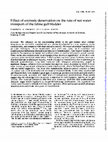
The influence on the concentrating ability of the gall bladder after extrinsic denervation was st... more The influence on the concentrating ability of the gall bladder after extrinsic denervation was studied in anaesthetised cats, previously subjected to truncal vagotomy and/or coeliacectomy, and compared with sham operated controls. Net water absorption was studied by perfusion techniques. Acute experiments were performed under basal conditions and ax-adrenoceptor stimulation (intra-arterial infusion of noradrenaline). Gall bladder biopsies were studied by fluorescence microscopy and cytofluorimetry to visualise and quantify catecholamines. Three weeks after coeliacectomy basal absorption had decreased significantly. In the short term vagotomy group no changes were shown. In the long term vagotomy group, however, there was a four-fold increase in absorptive capacity, which decreased to control levels after o-adrenoceptor blockade (phentolamine). Long term vagotomy with subsequent coeliacectomy caused no significant changes. Infusion of noradrenaline increased net water absorption by 60±11% in all experimental groups except in long term vagotomised animals, where the high basal absorption was not further augmented. One hour after noradrenaline infusion controls returned to basal absorption rate, while denervated cats remained at stimulated levels. In long term vagotomised gall bladders there were morphological signs of adrenergic proliferation (increased total number of nerve terminals, sprouting and raised levels of intraneuronal noradrenaline). These results suggest that the adrenergic nervous system is important for full absorptive capacity of the gall bladder. The increased absorption after long term vagotomy, abolished after ax-adrenoceptor blockade, might well be explained by the parallel adrenergic proliferation. This hypothesis was further corroborated in animals with long term vagotomy, where subsequent surgical adrenergic denervation restored basal absorption to control levels.
Gastroenterology, 1976
The vagal nerve of man has been investigated for the presence of adrenergic nerve fibres using th... more The vagal nerve of man has been investigated for the presence of adrenergic nerve fibres using the histochemical fluorescence method of Hillarp and Falck. Following 30-60 min of nerve ligation during surgical operations, the right anterior main trunk (subdiafragmatic level) from one patient, and the anterior nerve of Latarget of 5 patients were found to contain unmyelinated nerve fibres with accumulations of green fluorescent material representing a catecholamine. The observations indicate the presence of adrenergic nerve fibres running caudally in the human vagal nerve, in accordance with similar findings in other mammals, e.g. cats and dogs.
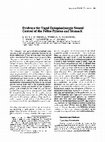
Gastroenterology, 1980
The atropine-and guanethidine-resistant contraction of the cat pyloric sphincter induced by effer... more The atropine-and guanethidine-resistant contraction of the cat pyloric sphincter induced by efferent stimulation of the cervical vagi, was studied with a new method for measuring transpyloric flow. The pyloric contraction was blocked in a dose-dependent manner by the opiate antagonist naloxone infused intraarterially to the pyloric region. Local intraarterial injection of morphine or enkephalinamide elicited a pyloric and gastric contraction. Leuand met-enkephalin intraarterially elicited a pyloric contraction and a gastric relaxation. These effects could be prevented or reversed by naloxone. Jmmunohistochemical studies revealed a particularly rich enkephalinergic innervation of the pylorus with dense networks of varicose nerve fibers with enkephalin-like immunoreactivity both in the circular smooth muscle layer and in the myenteric plexus. Furthermore, many cell bodies of the myenteric plexus with enkephalin-like material were demonstrated. The corpus-antrum was sparsely innervated by enkephalin-like nerves to the circular muscle layer and only few immunoreactive cell bodies were observed in the myenteric plexus. These results together suggest a vagal control of the feline pylorus and stomach mediated via enkephalinergic neurons. Recently, a method was described for the simultaneous recording of both gastric motility and transpyloric flow of saline in anesthetized cats.' It has previously been demonstrated that the vagi contain

British Journal of Cancer, 1991
The use of a somatostatin analogue (SMS 201-995) has greatly facilitated the treatment of patient... more The use of a somatostatin analogue (SMS 201-995) has greatly facilitated the treatment of patients with the midgut carcinoid syndrome. Clinical studies have shown that SMS reduces the peripheral levels of tumour-produced serotonin (5-HT) and tachykinins, e.g. neuropeptide K (NPK), basally and after pentagastrin provocation. Some studies have indicated an inhibitory effect of SMS on tumour cell growth as well. In the present study we have investigated the effects of SMS on four different human midgut carcinoid tumours maintained in long term culture. Media levels of 5-HT and NPK-LI in tumour cell cultures decreased rapidly during incubation with SMS (10-8-10-'OM) in all four tumours studied without evidence for tachyphylaxis (up to 6 weeks observation period). SMS treatment (10-8 M) during 4 days reduced the media concentrations of 5-HT by 56%, while the intracellular contents of 5-HT were decreased by 27% indicating dual inhibitory effects on synthesis and secretion of 5-HT from tumour cells. The DNA contents of cultures were not affected by SMS (10-8M or 10-`M) treatment for 4 or 14 days. When tumour cell cultures were challenged with isoprenaline (IP) (10-6 M) no reduction of the IP induced release of 5-HT could be detected after pretreatment of tumour cell cultures with SMS (10-8 M) for 1 h, 4 h or 4 days. These studies provide evidence for a direct action of the somatostatin analogue on midgut carcinoid tumour cells, reducing both synthesis and secretion of hormones from tumour cells. This effect appears not to be related to inhibition of tumour cell growth. The inhibition of 5-HT secretion from tumour cells by SMS seems to operate via a second messenger system different from the one mediating the 1-adrenoceptor stimulated release of 5-HT.

British Journal of Cancer, 1987
Somatostatin is a tetradecapeptide with potent inhibitory actions on several endocrine systems; i... more Somatostatin is a tetradecapeptide with potent inhibitory actions on several endocrine systems; it blocks the release of growth hormone, follicle stimulating hormone and thyrotropin from the pituitary gland (Krulich et al., 1968; Brazeau et al., 1973; Hall et al., 1978; Reichlin, 1983) and several peptide hormones from the endocrine gut and pancreas (Cohen et al., 1978; Gerich, 1981). It also affects exocrine and other functions of the gut, i.e. inhibits motility and absorption and decreases gut blood flow (cf. Arnold & Lankisch, 1980). Somatostatin also inhibits flushing in the carcinoid syndrome by reducing peripheral serotonin (5-HT) levels (Frolich et al., 1978). Recently synthetic somatostatin analogues have become available. Such compounds have been used both chronically and acutely to relieve symptoms caused by excessive secretion of tumour products (biogenic amines, peptide hormones) from carcinoid lesions of the gastrointestinal tract (cf. Bloom & Greenwood, 1985; Kvols et al., 1985). Such analogues may act at several levels, i.e. impaired release of tumour products, interaction with released peptides, blockade or desensitation of tumour receptors.
Diagnosis and Treatment of Autism, 1989
In the autistic child a diversity of symptoms can be present, but some major common traits are ob... more In the autistic child a diversity of symptoms can be present, but some major common traits are obvious. One major sign of autism in childhood is the lack of a normal interest in people, things and events. Some children with autism even avoid actively to become at all involved with people or other aspects of the environment. They may dislike input from the surroundings, be it the loving touch of a parent, direct eye contact or other stimuli of any of their 5 senses.

Neuroscience, 1993
Using immunofluorescence and cytofluorimetric scanning techniques in the rat, the fast anterograd... more Using immunofluorescence and cytofluorimetric scanning techniques in the rat, the fast anterograde and retrograde axonal transport of growth-associated protein-43-like immunoreactivity in normal sciatic nerves, and after spinal cord transection in the lower thoracic region, were investigated. Spinal roots and motor endplates in the peroneal muscles were also studied. For comparison, anti-synaptophysin (p38) was used. In intact adult animals, the amounts of immunoreactive growth-associated protein-43 increased linearly, both proximally and distally to the crush site, between I and 24 h after crushing the sciatic nerve. The a~~ulations were present in thick as well as in thin axons. Distal a~~ulations in the sciatic nerve were about 4060% of the proximal amounts, indicating a recycling of organ&es with growth-associated protein-43-like immunoreactivity. During the week after spinal cord transection, no clear changes were observed; the anterograde transport of growth-associated protein-Q-like immunoreactivity showed a tendency to decrease at day 1 and then a tendency to increase, reaching 120% of control at seven days (not significant). Transported p38-like immunoreactivity showed similar but smaller changes. In the lumbar spinal cord gray matter many nerve terminals with growth-associated protein-43-like immunoreactivity were seen in intact animals. After spinal transection, these terminals gradually decreased, suggesting that they belonged to descending pathways. However, p38-positive terminals were not obviously decreased. After crushing ventral and dorsal roots, accumulations pf growth-associated protein-43-like immunoreactivity were present in thick axons in the ventral roots and in thin to medium-sized axons in the dorsal roots. In peroneal muscles, growth-associated protein-43-like immunoreactivity was present in some (but not all) motor endplates in all groups. These results indicate that: (i) growth-associated protein-43 is normally present in nerve terminals of many descending projections of the spinal cord; (ii) forth-associated protein-43-like immunoreactivity is expressed and bidirectionally transported in neurons (motor as well as sensory) of normal sciatic nerves; (iii) growth-associated proton-43-like immunoreactivity is present in some adult motor endplates; and (iv) inhibited supraspinal input causes minor, if any, alterations-parallels by p38-in axonal transport of growth-associated protein-43.like immunoreactivity The growth associated protein 43 (GAP 43), identical to B-SO, pp48 and F1,17.M.33.36.40.46 is widely present in the developing rat central nervous system's~2D and in peripheral autonomic neurons and sensory neurons in rats."52 The protein is an integral constituent of the axonal growth cone.'s,32*47 In addition, this phosphoprotein is also expressed in the regenerating axon after injury of sciatic nerve in raL4* Previous studies showed that during regeneration, GAP 43 was rapidly transported in anterograde direc

Scandinavian Journal of Gastroenterology, 1989
Rectal biopsy specimens from patients with ulcerative proctitis/proctosigmoiditis (UP/PS) were in... more Rectal biopsy specimens from patients with ulcerative proctitis/proctosigmoiditis (UP/PS) were investigated immunocytochemically. In general, a changed mucosal innervation was demonstrated, with a marked increase in the number of nerve fibres and terminals with neuropeptide Y and tyrosine hydroxylase. In a few patients a hyperinnervation with VIPergic or SPergic nerves was seen. These findings indicate that hyperactive local nervous reflexes are of pathogenetic importance. To silence such activity, the diseased mucosa was treated with topically applied lidocaine. Such topical treatment with lidocaine gel in 21 consecutive patients with UP/PS for 3-8 weeks caused a rapid decrease of subjective and objective symptoms. During treatment mucosal integrity was restored, accompanied by depletion of OKT4 and OKT8 lymphocytes from the mucosa. However, the hyperinnervation pattern persisted during treatment.
Neuroscience, 1994
The distribution of synaptotagmin I in the peripheral nervous system of the rat was investigated ... more The distribution of synaptotagmin I in the peripheral nervous system of the rat was investigated by immunofluorescence and confocal laser scanning microscopy. After crushing of the sciatic nerve, synaptotagmin I-like immunoreactivity accumulated proximally as well as distally to the crushes in thin and medium-sized axons. Double labelling studies revealed that synaptotagmin I co-localized with tyrosine hydroxylase, a marker of sympathetic adrenergic neurons, and with substance P, a marker for sensory neurons. No synaptotagmin I-like immunoreactivity was found in large axons, while accumulations of the synaptic vesicle proteins synaptophysin and synapsin I were found in all types of axons. Furthermore, no synaptotagmin I-like immunoreactivity was detected in motor endplates. In contrast, the protein was found in muscle spindles of young rats and in perivascular

Journal of Neural Transmission, 1986
This study was performed to investigate how much of the acetylcholine (ACh), choline acetyltransf... more This study was performed to investigate how much of the acetylcholine (ACh), choline acetyltransferase (ChAT) and ACh-esterase (AChE) in the rat sciatic nerve originate from the somatic motor input and from the automatic sympathetic input, respectively. The somatic motor axons to the sciatic nerve were eliminated by surgical transsection of the spinal roots, (rhizotomy) and the autonomic component was removed by surgical resection of the lumbar sympathetic chain bilaterally (sympathectomy). Also combined operations were performed. In intact (non-crushed) sciatic nerve rhizotomy caused a reduction in ACh content by 70%, in ChAT-activity by 55%, and in AChE-activity by 41%. Sympathectomy alone had very little influence on ACh and ChAT, but reduced AChE by 20%. After crushing the nerve 13 hours before sacrifice, all three substances accumulated proximal to the crush region as described previously. When compared to the control group, sympathectomy alone caused a reduction in accumulated amounts of AChE only, while ACh and ChAT accumulations were essentially unchanged. Rhizotomy alone caused a substantial reduction in accumulated amounts of all three substances, but most prominently in ACh and ChAT-amounts. After sympathectomy in combination with rhizotomy ACh-accumulations were very low, and enzyme activities were reduced more than in the group with rhizotomy alone. A certain amount of residual ChAT and AChE was present in the nerve, and the location of this is discussed. The fact that combined sympathectomy and rhizotomy lowered ACh accumulations significantly more than would be expected from the results after either operation alone is commented upon.
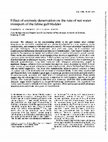
Gut, 1984
The influence on the concentrating ability of the gall bladder after extrinsic denervation was st... more The influence on the concentrating ability of the gall bladder after extrinsic denervation was studied in anaesthetised cats, previously subjected to truncal vagotomy and/or coeliacectomy, and compared with sham operated controls. Net water absorption was studied by perfusion techniques. Acute experiments were performed under basal conditions and ax-adrenoceptor stimulation (intra-arterial infusion of noradrenaline). Gall bladder biopsies were studied by fluorescence microscopy and cytofluorimetry to visualise and quantify catecholamines. Three weeks after coeliacectomy basal absorption had decreased significantly. In the short term vagotomy group no changes were shown. In the long term vagotomy group, however, there was a four-fold increase in absorptive capacity, which decreased to control levels after o-adrenoceptor blockade (phentolamine). Long term vagotomy with subsequent coeliacectomy caused no significant changes. Infusion of noradrenaline increased net water absorption by 60±11% in all experimental groups except in long term vagotomised animals, where the high basal absorption was not further augmented. One hour after noradrenaline infusion controls returned to basal absorption rate, while denervated cats remained at stimulated levels. In long term vagotomised gall bladders there were morphological signs of adrenergic proliferation (increased total number of nerve terminals, sprouting and raised levels of intraneuronal noradrenaline). These results suggest that the adrenergic nervous system is important for full absorptive capacity of the gall bladder. The increased absorption after long term vagotomy, abolished after ax-adrenoceptor blockade, might well be explained by the parallel adrenergic proliferation. This hypothesis was further corroborated in animals with long term vagotomy, where subsequent surgical adrenergic denervation restored basal absorption to control levels.

Uploads
Papers by Annica Dahlström